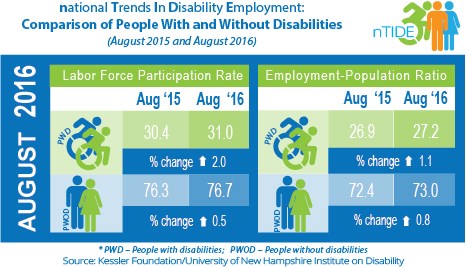WEST ORANGE, N.J., Sept. 2, 2016 (GLOBE NEWSWIRE) -- Improvement in the economic indicators for Americans with disabilities continued for the fifth consecutive month, according to today's National Trends in Disability Employment – Monthly Update (nTIDE), issued by Kessler Foundation and University of New Hampshire's Institute on Disability (UNH-IOD). As a result of the regulations of the Workforce Innovation & Opportunity Act (WIOA) and the efforts of the Advisory Committee on Increasing Competitive Integrated Employment for Individuals with Disabilities (ACICIEID), workers with disabilities are transitioning to new opportunities for better paying jobs. A number of initiatives are successfully facilitating the transitions, which has attracted the interest of private philanthropic organizations.
In the Bureau of Labor Statistics Jobs Report released Friday, September 2, the employment-to-population ratio for working-age people with disabilities increased from 26.9 percent in August 2015 to 27.2 percent in August 2016 (up 1.1 percent; 0.3 percentage points). For working-age people without disabilities, the employment-to-population ratio also increased from 72.4 percent in August 2015 to 73.0 percent in August 2016 (up 0.8 percent; 0.6 percentage points). The employment-to-population ratio, a key indicator, reflects the percentage of people who are working relative to the total population (the number of people working divided by the number of people in the total population multiplied by 100).
"For the fifth month in a row, we see improvement in the employment-to-population ratio for people with disabilities," noted John O'Neill, PhD., director of employment and disability research at Kessler Foundation. "And these gains are greater than those made by people without disabilities. This pattern is parallel to what we saw in the first half of 2015 and we hope that it continues for the remainder of 2016."
The labor force participation rate for working-age people with disabilities increased from 30.4 percent in August 2015 to 31.0 percent in August 2016 (up 2.0 percent; 0.6 percentage points). For working-age people without disabilities, the labor force participation rate also increased from 76.3 percent in August 2015 to 76.7 percent in August 2016 (up 0.5 percent; 0.4 percentage points). The labor force participation rate is the percentage of the population that is working or actively looking for work.
"Similar to last month, these numbers show that not only are more people with disabilities working, but more are actively looking for work," said Andrew Houtenville, Ph.D., associate professor of economics at UNH. "We know this because the labor force participation rate went up by more than the employment-to-population ratio, percentage-point wise. This was not the case for people without disabilities."
In 2015, in response to WIOA and ACICIEID, several states began to phase out work centers where the majority of workers are people with disabilities earning subminimum wages. One New Jersey-based nonprofit, the Jewish Vocational Service of Metro West (JVS), began preparing to meet WIOA guidelines by planning for the transition of clients in its sheltered workshop to integrated competitive employment.
A person-centered approach is helping the JVS staff determine the job readiness and personal potential of each client, according to Addy Bonet, CEO of JVS. "This approach has had a dramatic positive impact on our clients, enhancing their interpersonal skills and their interactions with one another," noted Bonet. "Their views on employment have shifted. Now they are looking at the competitive marketplace and are more confident about getting a job. We're proud to take the lead in this workshop transition movement that has allowed us to further fulfill our mission of 'helping people help themselves.' This transition project is funded by a Community Employment Grant from Kessler Foundation.
In August 2016, among workers ages 16-64, the 4,287,000 workers with disabilities represented 3.0 percent of the total 142,854,000 workers in the U.S.
The next nTIDE will be issued on Friday, October 7, 2016.
Join our nTIDE Lunch & Learn series, starting today, September 2 at 12:00PM EST. This live broadcast hosted via Zoom Webinar will offer attendees Q&A on the latest nTIDE findings, provide news and updates from the field of Disability Employment, as well as host-invited panelists to discuss current disability-related findings and events. David Mank, PhD, Chair, Advisory Committee on Increasing Competitive Integrated Employment for Individuals with Disabilities, joins Drs. Houtenville, O'Neill, and Michael Gamel-McCormick from AUCD, to discuss today's findings. You can join live, or watch the recordings at http://www.researchondisability.org/home/ntide
NOTE: The statistics in the National Trends in Disability Employment – Update are based on Bureau of Labor Statistics numbers, but are NOT identical. They have been customized by the University of New Hampshire to efficiently combine the statistics for men and women of working age (16 to 64).
nTIDE is funded, in part, by grants from the National Institute on Disability, Independent Living and Rehabilitation Research (NIDILRR) (90RT5022-02-00 & 90RT5017) and Kessler Foundation.
About Kessler Foundation
Kessler Foundation, a major nonprofit organization in the field of disability, is a global leader in rehabilitation research that seeks to improve cognition, mobility and long-term outcomes, including employment, for people with neurological disabilities caused by diseases and injuries of the brain and spinal cord. Kessler Foundation leads the nation in funding innovative programs that expand opportunities for employment for people with disabilities. For more information, visit KesslerFoundation.org.
About the Institute on Disability at the University of New Hampshire
The Institute on Disability (IOD) at the University of New Hampshire (UNH) was established in 1987 to provide a coherent university-based focus for the improvement of knowledge, policies, and practices related to the lives of persons with disabilities and their families. For information on the NIDILRR-funded Employment Policy and Measurement Rehabilitation Research and Training Center, visit www.ResearchonDisability.org.
For more information, or to interview an expert, contact:
Carolann Murphy, 973.324.8382, CMurphy@KesslerFoundation.org
A photo accompanying this release is available at: http://www.globenewswire.com/newsroom/prs/?pkgid=41309
